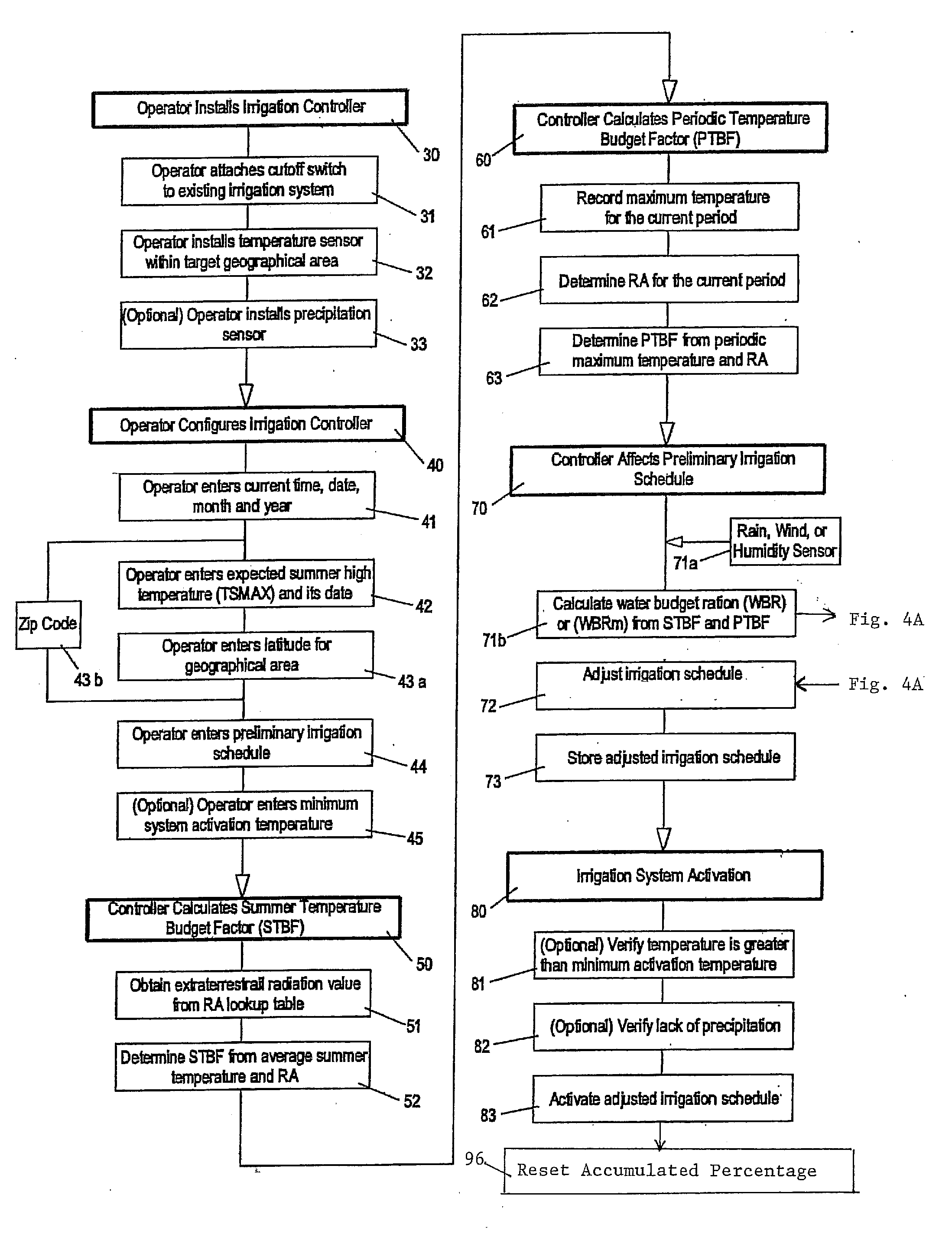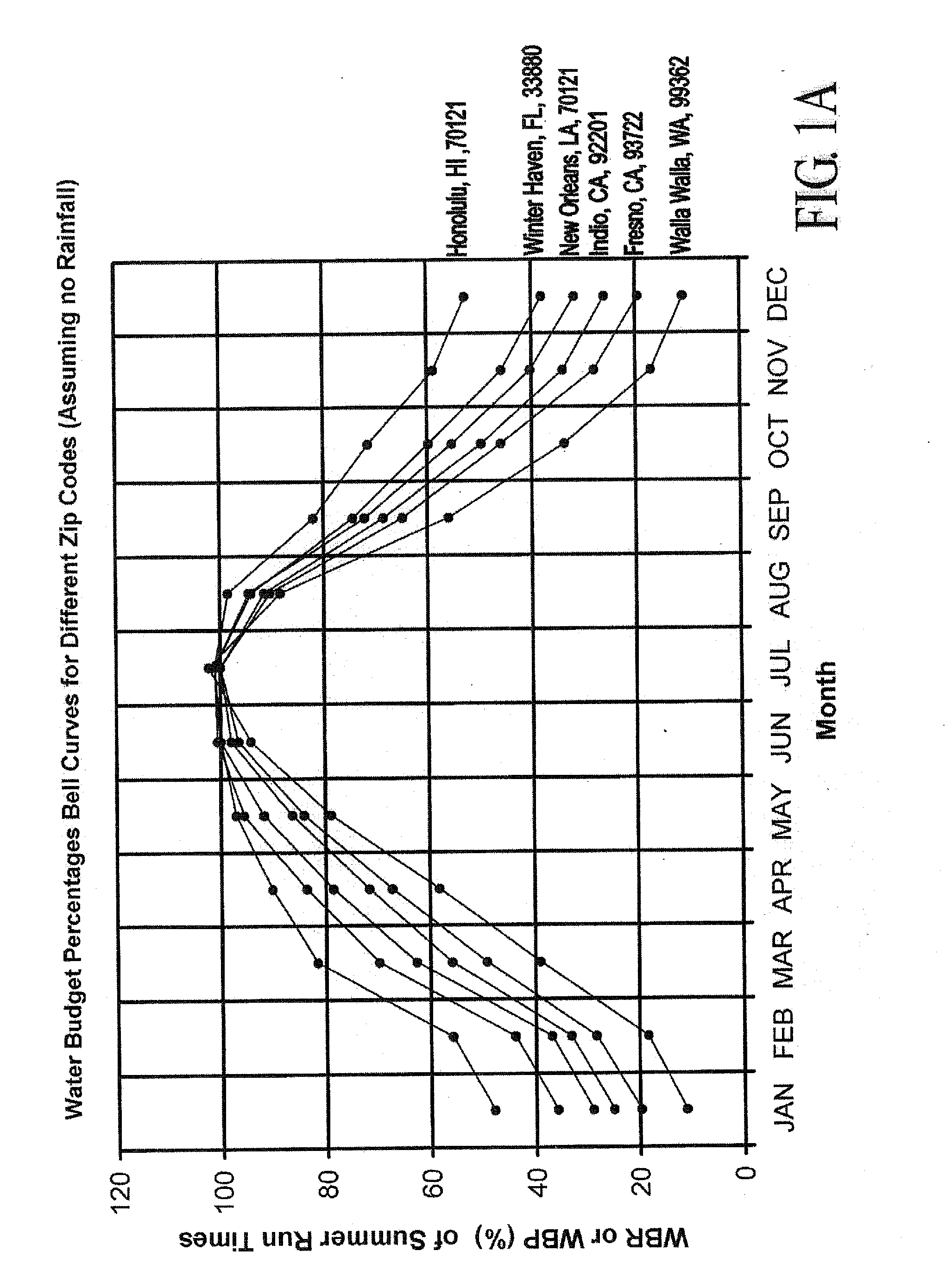Many regions of the United States lack sufficient
water resources to satisfy all of their competing agricultural, urban, commercial and environmental needs.
However, an add-on is typically mounted on the output of an
irrigation controller and usually breaks the
common line to control irrigation.
As stated in this applicant's previous applications, ET based controllers, add-ons and plug-ins, while theoretically effective, were projected to be far too complicated or expensive or required monthly service fees to be an effective practical means for meaningful water conservation.
Furthermore, studies have shown that within one year of installation, less than half of those ET based smart controllers are still being used in their Smart mode.
Due to the poor performance of ET based controllers, the Commission has suspended its meetings, leaving the implementation of bill 1881 in doubt.
The reasons for its suspension are disagreement within the industry, disappointment of ET based controller performance, very poor sales of smart controllers in
spite of rebates, and the state of California's economy.
In addition to the need for water conservation, many urban areas do not have the infrastructure necessary to serve their communities, which include pumping, delivery, and
water pressure issues.
As a consequence, many water districts have implemented restricted watering schedules to stabilize water deliveries and save water.
The present invention nor its predecessors do not state that ET and soil
moisture based methods are not possible ways to help conserve water, but as currently embodied in other controllers (see Bureau of Reclamation report referenced herein), controllers and currently available ET methods are difficult to understand and implement.
A significant portion of this projected shortage was attributed to user
neglect and
system inefficiency in landscape irrigation.
It further estimated that approximately one-third of the
irrigation water was wasted, either due to inefficient irrigation systems or inadequate controller
programming, oftentimes due in part to complicated controller
programming procedures required of the operator.
This results in a total annual waste of 1.81 maf of water for California households alone.
Such water shortages have forced many municipalities to enact strict water conservation measures.
However, after at least six years, there is still no
consensus among consumers, water agencies, manufacturers, or state or federal government entities as to the most effective water conservation method or automated controls.
For example, the California Energy Commission has suspended its proceedings for recommending labeling and sales standards; the California Department of
Water Resources is not prepared to make recommendations concerning implementation of California
Assembly Bill 1881 which would have required all irrigation controllers sold in California by January 2012 to be “smart.”
The use and efficiency factors of ET based smart controllers is still in doubt.
A recent large study of 3112 ET based controllers installed throughout California conducted by AquaCraft revealed a disappointing 6% water savings.
In addition, much fewer than 1% conversion to smart controllers has been accomplished after seven years throughout the U.S., and of those, about half were either not programmed correctly due to ET complexity, or not used in their smart mode within the first year of installation, partially due to monthly ET data service fees.
Furthermore, there is significant disagreement with regard to the EPA's WaterSense labeling proposals by the
Irrigation industry.
These continuing uncertainties and inefficiencies, along with cost, complexity, and the current state of the economy (which has deteriorated significantly since 2006) continue to slow efforts to convert to smart controller technology.
No matter how much water is theoretically saved by ET systems, the reality is that very little real water savings has been recorded to date using the currently available ET based and soil
moisture sensing methods, even after the past six years of public education and municipal rebates.
The relatively high cost of labor in many municipalities further prohibits frequent manual adjustments of irrigation controllers in the commercial and municipal markets.
This generally results in over-irrigation and runoff, particularly during the off-seasons, oftentimes by as much as one to two hundred percent.
As an alternative to ET, soil moisture sensing devices and other methods of water conservation have been available for decades, but have enjoyed only limited success.
Such devices and methods are often problematic due to the location and number of sensors necessary to obtain accurate soil moisture readings, the high costs of installing and maintaining the sensors, and the integrity and reliability of the sensors' data.
The inventions described herein are not so much theoretical as practical and user-friendly alternative approaches to water conservation with greater potential to save real rather than theoretical water.
While the replacement of the water in the
vegetation root zone by means of theoretically calculated ET has been of academic interest for over fifty years, methods incorporating ET formulas, and the installation, comprehension and
programming of controllers utilizing such methods, including those cited in the referenced patents above, are generally far too complex for the average user to understand and implement.
These programs have had limited effect and a short-term
impact.
Unfortunately, until now, these large landscape control systems have been far too complex and expensive for residential applications.”
The sheer number of variables renders ET theory difficult to explain, understand and apply, especially for an unsophisticated
consumer with little or no scientific or meteorological background.
Such unfamiliarity and complexity increase the margins of error already associated with the various ET formulas, further diminishing their effectiveness.
Water districts, irrigation consultants, manufacturers, the
Irrigation Association, the Center for
Irrigation Technology and other attendees at the EPA's Water Efficient Product Market Enhancement Program estimated that, due to the complexity, cost, impracticality of installation and difficulty in programming current irrigation controllers, less than one percent of all commercial and residential landscape irrigation systems currently and effectively utilize some form of the ET or moisture sensing method.
While manufacturers, water districts, and irrigation consultants have accepted the concept of smart controllers as a means of landscape water conservation, homeowners (the users) have still not embraced this technology after seven years of education and encouragement with rebates.
Even if the ET or ground moisture sensing methods provided one hundred percent efficiency, which they do not, the limited adoption of these methods renders them an ineffective means of significant water conservation, since less than one percent of the water waste would be prevented.
Given the numerous microclimates existing within any one geographical area, data received from remotely located sensors may be inaccurate.
The data must also be received and processed in real-time, since average or historical ET data may be inaccurate during periods of unusual or excessive heat, cold, or rain, or other deviations from historical climate patterns.
Any inaccurate data would result in even greater ET deviations and inefficient irrigation.
However, general trends may still be identified, even with inaccurate ET data.
ET measuring devices are generally also expensive to install and maintain.
The sensors and stations must also be powered in some manner—depending upon the particular geographic location,
AC power may not be readily available.
All of these considerations increase the cost of implementing an ET-based irrigation
system to a prohibitive level, and limit the widespread adoption of this method.
Some areas, such as street medians or parks, are not suitable for
weather station or sensor installation due to aesthetic reasons or the likelihood of vandalism.
Such information is not readily available to the average
consumer.
Unsurprisingly, such approaches have met with limited success.
Therefore, the implementation of 1881 will most likely be delayed and standards not published in the near future due to the suspension of the California Energy Commission meetings due to disagreements within the industry and fiscal reasons.
The problem of irrigation mismanagement, and the main hurdle faced by these entities, can be simply summarized as follows: once a
system is properly designed and installed, most of the wasted landscape
irrigation water and runoff is caused by not adjusting for daily, periodic, or seasonal changes.
If the summer schedule is assumed to be 100%, and November irrigation actually only requires, for example, about 20% of summer irrigation to satisfy the
vegetation needs, this means that as much as 80% of the water is wasted in the fall.
Such inaction is usually caused by the complexity and difficulty of determining the particular adjustment amounts and the significant inconvenience of daily adjustments.
As discussed in provisional patent applications 60 / 831,904 and 60 / 899,200 (which have been incorporated above), many communities also have
water pumping and delivery issues due to drought and increasing
population and demand on the infrastructure delivering that water.
However, this method is difficult to police because there are 500,000 customers in Clark County, Nev., so many users commonly violate these rules.
It is inconvenient for the homeowner, for example, to remember to change the watering schedule and comply with the allowed watering times of the day at least 4 times a year, particularly if they are not familiar with the programming of the controller.
While ET based controllers address newly installed systems, existing non smart controllers, including battery powered controllers have not been addressed.
Since it will most likely take a decade to replace all existing controllers with smart controllers, some simple inexpensive methods are needed to save water in the interim, because ET based methods and soil moisture sensors have not been effective in providing meaningful water conservation over the last decade since the use of ET was promoted within the irrigation industry and state and federal government agencies The relatively low cost of water, the ET based controller's initial high cost and complexity, and monthly service fees have contributed to the very low usage of ET based controllers, add-ons, plug ins.
 Login to View More
Login to View More  Login to View More
Login to View More 


